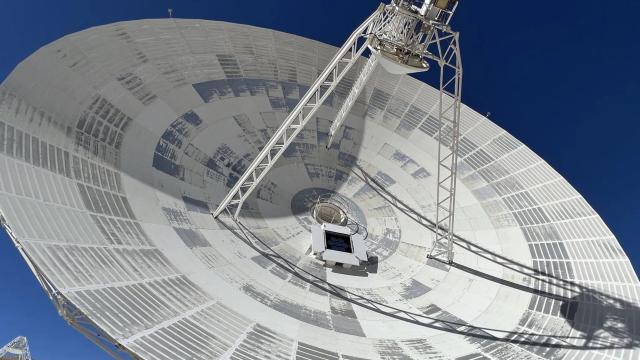NASA outfitted its aging communications network with a hybrid antenna that allowed it to receive both radio frequency and laser signals for the first time, helping the space agency keep up with its increasing number of missions traveling through deep space.
Deep Space Station 13, an experimental 112-foot-long (34-meters) radio-frequency-optical-hybrid antenna, tracked and decoded a signal from a gold-capped laser transceiver attached to NASA’s asteroid probe Psyche, the space agency recently announced. The Deep Space Optical Communications (DSOC) experiment launched on board the Psyche spacecraft on October 13, 2023 as the first demonstration of laser, or optical, communications from as far away as Mars.
On January 1, 2024, the hybrid antenna downlinked a team photograph that had been uploaded to DSOC before Psyche’s launch. “Our hybrid antenna has been able to successfully and reliably lock onto and track the DSOC downlink since shortly after the tech demo launched,” Amy Smith, DSN deputy manager at Jet Propulsion Laboratory (JPL), said in a statement. “It also received Psyche’s radio frequency signal, so we have demonstrated synchronous radio and optical frequency deep space communications for the first time.”
The antenna is part of NASA’s Deep Space Network (DSN), an array of giant radio antennas spread across different parts of the world that the space agency has relied on to relay communications with its deep space missions for the past 60 years. The network is made up of 14 dishes distributed across three deep-space communications facilities at Goldstone in California’s Mojave Desert, another near Madrid, Spain, and the third near Canberra, Australia. The recent experiment took place at the California facility.
The trusty communications network is struggling to keep up with demand as NASA launches more missions to deep space. A recent report by NASA’s Office of Inspector General revealed that demand on DSN exceeds supply by as much as 40% at times. By retrofitting the radio antennas with the experimental hybrid capability, NASA is hoping to transmit more data at a faster rate, as well as help DSN keep up with the high demand.
In late 2023, the hybrid antenna downlinked data from 20 million miles (32 million kilometers) away at a rate of 15.63 megabits per second. That’s about 40 times faster than radio frequency communications at that distance, according to NASA.
This dramatic increase in data transfer speed enables the transmission of more detailed information from deep space missions, enhancing our understanding of the solar system. It also paves the way for more efficient communication with future space explorations, potentially revolutionizing how we explore and study our universe. What’s more, laser communications can transmit data at a substantially higher rate, enabling the rapid transfer of high-resolution images and extensive scientific data from distant space missions.
Deep Space Station 13 has seven ultra-precise segmented mirrors (similar to the hexagonal mirrors of the Webb Telescope) attached to the inside of its curved surface. Each mirror reflects the laser photons and redirects them into a high-exposure camera attached to the antenna’s subreflector, which is located above the center of DSN’s giant dish. The laser signal collected by the camera is then transmitted through optical fiber that feeds into a cryogenically cooled semiconducting nanowire single photon detector, which acts as a downlink ground station.
“We use a system of mirrors, precise sensors, and cameras to actively align and direct laser from deep space into a fiber reaching the detector,” Barzia Tehrani, communications ground systems deputy manager and delivery manager for the hybrid antenna at JPL, said in a statement.
The team wants to test the hybrid antenna at a distance equivalent to that between Earth and Mars at its farthest point (or two and a half times the distance between the Sun and Earth). In June, the Psyche spacecraft will have reached that distance, and its onboard laser transceiver will be ready to beam a signal to the antenna.
In December 2023, DSOC beamed a 15-second-long video of an orange tabby cat named Taters chasing a laser pointer up and down a couch while 19 million miles away from Earth. It’s kind of hard to top that, but we’ll see what the laser transceiver has in store for us next.
